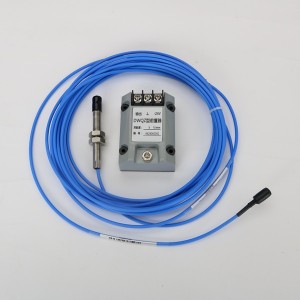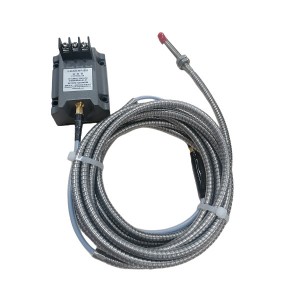Accurate steam turbine shaft vibration measurement relies heavily on the eddy current proximity probe preamplifier TM301-A02-B01-C00-D00-E00-F00-G00. It acts as the “signal relay station,” amplifying and processing the shaft vibration signal collected by the probe before transmitting it to the monitoring system. If the preamplifier fails, the signal will be either lost or corrupted, rendering the monitoring system “blind” and unable to detect excessive shaft vibration.
The operating environment around a steam turbine is often hostile. High temperatures (e.g., near the cylinder or bearings) and high humidity (e.g., near the condenser or during rainy seasons) are common, and these two conditions are particularly prone to causing failures in this preamplifier model. Below, we detail the specific problems caused by high-temperature and high-humidity environments and outline critical maintenance considerations.
High-Temperature Environment: Corrupted Signals, Component Failure, and Monitoring Errors
The high-temperature environment around a steam turbine is characterized by sustained heat, not just brief exposure. In certain locations, temperatures remain elevated year-round, slowly penetrating the preamplifier’s interior and affecting the circuitry and components.

1. Signal Drift: Shaft Vibration Data “Floats” Erratically
The TM301-A02-B01-C00-D00-E00-F00-G00 preamplifier contains many precise circuits, such as amplifiers and filters. Components like resistors and capacitors in these circuits are highly sensitive to temperature. Continuous heat exposure causes resistance values and capacitance to drift, scrambling the circuit’s parameters.
Example: If the shaft vibration is stable at 0.05 mm, the preamplifier’s output signal corresponds to this value, and the monitoring system shows normal. When parameters shift under high heat, the signal “drifts”—the monitoring system might show 0.08 mm, or the reading might fluctuate wildly, even if the actual shaft vibration hasn’t changed. Operating personnel relying on this false signal might make incorrect adjustments or misdiagnose a fault, potentially harming the unit.
If you observe that the preamplifier’s output signal is unstable, with shaft vibration data jumping around (after eliminating probe issues), the high probability is signal drift caused by high temperatures. You can contact us to help check the circuit parameters and determine if compensation adjustment is needed.
2. Component Aging: Preamplifier Suddenly “Quits”
High temperatures accelerate the aging of internal components. For example, the electrolyte in electrolytic capacitors dries out faster in high heat, causing a rapid decline in capacitance. Transistors also experience performance degradation during prolonged high-temperature operation, often leading to sudden failure.
When these components fail, the preamplifier can simply “stop working”—either there is no signal output, and the monitoring system displays “No Data,” or it outputs an incorrect signal, such as a constant maximum or minimum value. A sudden preamplifier failure during turbine operation means maintenance staff lose real-time shaft vibration data, forcing them to reduce load for inspection, which impacts production.
Note: Many power station preamplifiers fail before their expected lifespan. Examination often reveals bulging capacitors or burnt transistors, primarily resulting from long-term operation in high-temperature environments.
3. Insulation Failure: Short Circuits and Component Burnout—Higher Risk
The circuit boards and wires inside the preamplifier have insulating layers. High temperatures can cause the insulation to soften, become brittle, or even peel away. When the insulation fails, short circuits can occur between wires—for instance, a hot line contacting a neutral line. The resulting sudden high current not only burns the circuit board but can also cause a trip, affecting other equipment.
This situation is more dangerous than component aging. A short circuit may produce sparks, posing a safety risk if oil residue or dust is present nearby. Furthermore, a short-circuited preamplifier is usually irreparable and requires replacement, incurring higher costs.
High-Humidity Environment: Dampness, Corrosion, Signal Loss, and Bias
The primary issue in a high-humidity environment is water—moisture seeps into the preamplifier, reacts with the circuitry and metal parts, triggering a cascade of failures.

1. Moisture-Induced Short Circuit: Circuit “Bridges,” Signal Interrupted
The TM301-A02-B01-C00-D00-E00-F00-G00 preamplifier casing is not fully sealed (it needs to dissipate heat and allow for wiring). In high humidity, moisture penetrates through cable entry points and casing gaps, settling on the circuit board.
Given the dense circuitry on the board, moisture acts as an “electrical bridge,” connecting lines that should be separate, causing a short circuit. Similar to high-temperature short circuits, moisture-induced shorts can lead to signal loss or even component burnout. However, moisture-related shorts are more insidious—they might not cause an immediate failure but instead lead to gradual signal degradation before a complete breakdown, making them hard for operators to anticipate.
Example: During the rainy season, preamplifiers near the condenser are especially vulnerable to moisture. In some power plants, a slight signal bias was initially ignored, only for the preamplifier to short circuit days later, forcing a shutdown for replacement.
2. Metal Corrosion: “Rusting” Connectors, Poor Contact
The preamplifier has many metal connectors and component pins. In a high-humidity environment, these metals react with moisture and airborne contaminants, leading to gradual rust and corrosion.
Corroded connectors result in poor contact—the signal passing from the probe is attenuated or completely disconnected as it crosses the corroded joint. This manifests in the monitoring system as an intermittent signal or a lower signal amplitude. For instance, an actual shaft vibration of 0.06 mm might be transmitted as 0.03 mm. The operator may miss the early warning of an elevated shaft vibration.
Troubleshooting poor contact is tedious—it requires opening the preamplifier and inspecting each connector, consuming time and effort. If you experience intermittent signals, contact us for troubleshooting; avoid unnecessary self-disassembly that wastes time.
3. Parameter Shift: Reduced Accuracy, Inaccurate Vibration Readings
Moisture not only causes short circuits and corrosion but also affects circuit parameters. For example, a damp circuit board can change its dielectric constant, degrading the filtering circuit’s performance. Resistors and capacitors that absorb moisture will also see their parameters drift.
Unlike high-temperature drift, high-humidity parameter shift is slower, and once components are saturated, parameters are difficult to restore. A preamplifier with a measuring accuracy of 0.001mm might degrade to 0.005mm after becoming damp. While it still functions, the reduced accuracy prevents the precise capture of tiny shaft vibration changes—often the earliest indicators of a developing fault.
Maintenance for High-Temperature and High-Humidity: Essential Extra Steps
Knowing the problems caused by high temperature and high humidity, maintenance must include targeted measures beyond a “routine check” used for normal environments.
High-Temperature Environment Maintenance: Cooling, Component Check, Insulation Protection
- Prioritize “Cooling”: Install the preamplifier away from high-temperature components (e.g., avoid mounting directly next to the cylinder or exhaust pipe). If relocation is impossible, add heat dissipation measures: install a small fan for direct airflow or attach heat sinks to the casing.
- Regular Component Checks: Every 3 months, open the preamplifier casing (after power-off). Check for bulging or leaking capacitors, discoloration or signs of overheating on transistors, and yellowing of the circuit board. Replace components immediately upon detection; don’t wait for total failure.
- Inspect Insulation Layers: Use a multimeter to measure the insulation resistance between circuits. If the value falls below standard, the insulation is likely compromised. Immediate action is required—such as cleaning the circuit board, re-coating with insulating varnish, or replacing the board.
High-Humidity Environment Maintenance: Sealing, Drying, Anti-Corrosion
- Focus on “Moisture-Proof Sealing”: Wrap waterproof tape around cable entry points and seal casing gaps with waterproof sealant to prevent moisture ingress. In extremely humid locations (e.g., below the condenser), install a waterproof cover over the preamplifier and place desiccants inside (replace regularly) to keep the interior dry.
- Regular Preamplifier “Drying”: Monthly, after power-off, open the casing and use a hairdryer (cool setting) to blow dry the circuit board, removing trapped moisture. A drying oven can also be used to ensure the circuit board and components are moisture-free.
- Prevent Metal Corrosion: Periodically inspect connectors and pins. Gently polish any signs of rust with fine-grit sandpaper, then apply a layer of anti-rust grease to slow down the corrosion rate. Contact us for detailed instructions on sealing and drying procedures.
General Maintenance: Calibration and Cable Check Are Musts
- Regular Calibration: Regardless of the environment, regular calibration is essential. Every 6 months, input a known signal to the preamplifier using a standard signal source and check the output for accuracy. Adjust parameters if necessary. Calibration corrects parameter drift and ensures measurement precision.
- Cable Inspection: The input and output cables of the preamplifier are prone to moisture and corrosion at the connection points. Regularly check for cable damage and connector rust. Replace damaged cables and treat corroded connectors promptly.

Get Preamplifier Maintenance and Selection Support
The TM301-A02-B01-C00-D00-E00-F00-G00 eddy current preamplifier is crucial for steam turbine shaft vibration monitoring but is susceptible to failures in high-temperature and high-humidity environments. If you encounter signal drift, component failure, or moisture-induced short circuits during maintenance, or if you need to select a suitable preamplifier for a high-temperature/high-humidity area, please contact us.
We offer not only detection and repair services for the TM301 series preamplifiers but can also recommend models that are more heat-resistant and moisture-proof based on your on-site environment. We help reduce faults, ensure accurate shaft vibration monitoring, and guarantee stable steam turbine operation.
E-mail: sales@yoyik.com
Tel: +86-838-2226655
Whatsapp: +86-13618105229
Yoyik offers various types of power plants spare parts for steam turbines, generators, boilers as below:
CPU board GD2511008
Vibration speed sensor WZ-GC
Expansion Monitor D-GD87-0906
RTD SENSOR WZPM2-201-B
Pressure switch LS1101HN-BH-026005-026
BRAUN MONITOR MODULE E1610
Percentage boards ME5.530.012
Bolt electric heating rod ZJ-16.5-13
LVDT FOR HP Quick closing Valves 4000TD
Position Transmitter TM301-A02-B00-C00-D00-E00-F00-G00
Heating rod DJ-15
MVC-196 Microcomputer Automatic Voltage Controller GGAj02K-15A/66kV 142kVA
Eddy Current Sensor PR6423/004-120
Eddy Current Sensor PR6422/000-021
speed mornitor ZKZ-2T
Indication AD16-22D/R32S/AC380V
intelligence Hand Operator NPDF-Q21F1
SWITCH LEVEL L3541CR-RH
BENTLY Preamplifier 330180-91-00
Temperature switch T724TS120 XFSJLNH 65/125C
Thermocouple WZPK-230
variable reluctance pickup CS-1(G-080-02-01)
TAP POSITION INDICATOR ET-SZ5A
intelligence Hand Operator NPDF-Q21D0
intelligence Hand Operator NPDF-Q21D5
Speed probe CS-01-G-100-03-01
RELAY PROTEKSI IN ST571H-25-VM
Fieldbus control device BH-COMM-TCP/MOD
Indoor CCTV Camera HDZ302LIW
Generator insulation overheat detector OHM
Controller NE9611/04
Online industrial conductivity meter CON5101GY
Post time: Oct-29-2025













